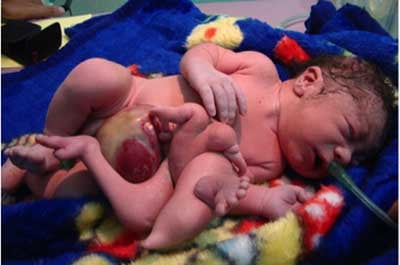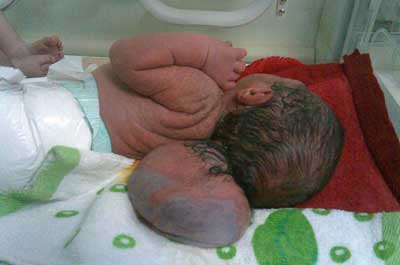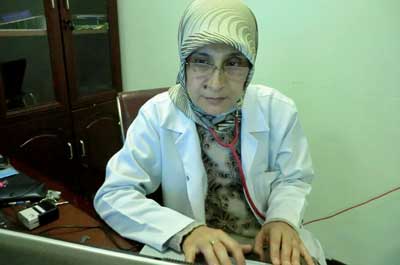
Contamination from Depleted Uranium (DU) munitions and other military-related pollution is suspected of causing a sharp rises in congenital birth defects, cancer cases, and other illnesses throughout much of Iraq.
Many prominent doctors and scientists contend that DU contamination is also connected to the recent emergence of diseases that were not previously seen in Iraq, such as new illnesses in the kidney, lungs, and liver, as well as total immune system collapse. DU contamination may also be connected to the steep rise in leukaemia, renal, and anaemia cases, especially among children, being reported throughout many Iraqi governorates.
There has also been a dramatic jump in miscarriages and premature births among Iraqi women, particularly in areas where heavy US military operations occurred, such as Fallujah.
Official Iraqi government statistics show that, prior to the outbreak of the First Gulf War in 1991, the rate of cancer cases in Iraq was 40 out of 100,000 people. By 1995, it had increased to 800 out of 100,000 people, and, by 2005, it had doubled to at least 1,600 out of 100,000 people. Current estimates show the increasing trend continuing.
As shocking as these statistics are, due to a lack of adequate documentation, research, and reporting of cases, the actual rate of cancer and other diseases is likely to be much higher than even these figures suggest.
“Cancer statistics are hard to come by, since only 50 per cent of the healthcare in Iraq is public,” Dr Salah Haddad of the Iraqi Society for Health Administration and Promotion told Al Jazeera. “The other half of our healthcare is provided by the private sector, and that sector is deficient in their reporting of statistics. Hence, all of our statistics in Iraq must be multiplied by two. Any official numbers are likely only half of the real number.”
Toxic environments
Dr Haddad believes there is a direct correlation between increasing cancer rates and the amount of bombings carried out by US forces in particular areas.
“My colleagues and I have all noticed an increase in Fallujah of congenital malformations, sterility, and infertility,” he said. “In Fallujah, we have the problem of toxics introduced by American bombardments and the weapons they used, like DU.”
During 2004, the US military carried out two massive military sieges of the city of Fallujah, using large quantities of DU ammunition, as well as white phosphorous.
“We are concerned about the future of our children being exposed to radiation and other toxic materials the US military have introduced into our environment,” Dr Haddad added.
A frequently cited epidemiological study titled Cancer, Infant Mortality and Birth Sex-Ratio in Fallujah, Iraq 2005-2009 involved a door-to-door survey of more than 700 Fallujah households.
The research team interviewed Fallujans about abnormally high rates of cancer and birth defects.
One of the authors of the study, Chemist Chris Busby, said that the Fallujah health crisis represented “the highest rate of genetic damage in any population ever studied”.
Dr Mozghan Savabieasfahani is an environmental toxicologist based in Ann Arbor, Michigan. She is the author of more than two dozen peer reviewed articles, most of which deal with the health impact of toxicants and war pollutants. Her research now focuses on war pollution and the rising epidemic of birth defects in Iraqi cities.
“After bombardment, the targeted population will often remain in the ruins of their contaminated homes, or in buildings where metal exposure will continue,” Dr Savabieasfahani told Al Jazeera.
“Our research in Fallujah indicated that the majority of families returned to their bombarded homes and lived there, or otherwise rebuilt on top of the contaminated rubble of their old homes. When possible, they also used building materials that were salvaged from the bombarded sites. Such common practices will contribute to the public’s continuous exposure to toxic metals years after the bombardment of their area has ended.”
She pointed out how large quantities of DU bullets, as well as other munitions, were released into the Iraqi environment.
“Between 2002 and 2005, the US armed forces expended six billion bullets – according to the figures of the US General Accounting Office,” she added.
According to Dr Savabieasfahani, metal contaminants in war zones originate from bombs and bullets, as well as from other explosive devices. Metals, most importantly lead, uranium, and mercury, are used in the manufacture of munitions, and all of these contribute to birth defects, immunological disorders, and other illnesses.
“Our study in two Iraqi cities, Fallujah and Basra, focused on congenital birth defects,” she said.
Her research showed that both studies found increasing numbers of birth defects, especially neural tube defects and congenital heart defects. It also revealed public contamination with two major neurotoxic metals, lead and mercury.
“The Iraq birth defects epidemic is, however, surfacing in the context of many more public health problems in bombarded cities,” she said. “Childhood leukemia, and other types of cancers, are increasing in Iraq.”
Fallujah babies
 Doctors in Fallujah are registering hundreds of babies with severe birth defects, which they attribute to DU munitions and other war toxins. (Photo: Dr Samira Alani / Al Jazeera)Doctors in Fallujah are continuing to witness the aforementioned steep rise in severe congenital birth defects, including children being born with two heads, children born with only one eye, multiple tumours, disfiguring facial and body
Doctors in Fallujah are registering hundreds of babies with severe birth defects, which they attribute to DU munitions and other war toxins. (Photo: Dr Samira Alani / Al Jazeera)Doctors in Fallujah are continuing to witness the aforementioned steep rise in severe congenital birth defects, including children being born with two heads, children born with only one eye, multiple tumours, disfiguring facial and body
deformities, and complex nervous system problems.
Today in Fallujah, residents are reporting to Al Jazeera that many families are too scared to have children, as an alarming number of women are experiencing consecutive miscarriages and deaths with critically deformed and ill newborns.
Dr Samira Alani, a pediatric specialist at Fallujah General Hospital, has taken a personal interest in investigating an explosion of congenital abnormalities that have mushroomed in the wake of the US sieges since 2005.
“We have all kinds of defects now, ranging from congenital heart disease to severe physical abnormalities, both in numbers you cannot imagine,” Alani told Al Jazeera at her office in the hospital last year, while showing countless photos of shocking birth defects.
Alani also co-authored a study in 2010 that showed the rate of heart defects in Fallujah to be 13 times the rate found in Europe. And, for birth defects involving the nervous system, the rate was calculated to be 33 times that found in Europe for the same number of births.
As of December 21, 2011, Alani, who has worked at the hospital since 1997, told Al Jazeera she had personally logged 677 cases of birth defects since October 2009. Just eight days later, when Al Jazeera visited the city on December 29, that number had already risen to 699.
Alani showed Al Jazeera hundreds of photos of babies born with cleft pallets, elongated heads, a baby born with one eye in the centre of its face, overgrown limbs, short limbs, and malformed ears, noses and spines.
 Multiple birth defects, many as severe as this, have become common with babies born in the aftermath of US assaults on the city. (Photo: Dr Samira Alani / Al Jazeera)She told Al Jazeera of cases of “thanatophoric displacia”, an abnormality in bones and the rib cage that “render the newborn incompatible with life”.
Multiple birth defects, many as severe as this, have become common with babies born in the aftermath of US assaults on the city. (Photo: Dr Samira Alani / Al Jazeera)She told Al Jazeera of cases of “thanatophoric displacia”, an abnormality in bones and the rib cage that “render the newborn incompatible with life”.
“It’s been found by a coroner’s court that cancer was caused by an exposure to depleted uranium,” Busby told Al Jazeera.
“In the last ten years, research has emerged that has made it quite clear that uranium is one of the most dangerous substances known to man, certainly in the form that it takes when used in these wars.”
In July 2010, Busby released a study that showed a 12-fold increase in childhood cancer in Fallujah since the 2004 attacks. The report also showed the sex ratio had become skewed to 86 boys born to every 100 girls, together with a spread of diseases indicative of genetic damage – similar to, but of far greater incidence than Hiroshima.
Dr Alani has visited Japan where she met with Japanese doctors who study birth defect rates they believe related to radiation from the US nuclear bombings of Hiroshima and Nagasaki.
She was told birth defect incidence rates there are between one and two per cent. Alani’s log of cases of birth defects amounts to a rate of 14.7 per cent of all babies born in Fallujah, more than 14 times the rate in the effected areas of Japan.
In March 2013, Dr Alani informed Al Jazeera that the incident rates of congenital malformations remained around 14 per cent.
As staggering as these statistics are, Dr Alani points to the same problem of under-reporting that Dr Haddad mentioned, and said that the crisis is even worse than these statistics indicate.
“We have no system to register all of them, so we have so many cases we are missing,” she said. “I think I only know of 40-50 percent of the cases because so many families have their babies at home and we never know of these, and other clinics are not registering them either.”
Additionally, Dr Alani remains the only person in Fallujah registering cases, and reported that she was still seeing the same severe defects.
“We have so many cases of babies with multiple system defects in one baby,” she explained. “Multiple abnormalities in one baby. For example, we just had one baby with central nervous system problems, skeletal defects, and heart abnormalities. This is common in Fallujah today.”
Disconcertingly, Dr Alani mentioned something that Dr Savabieasfahani’s research warned of.
 Dr Samira Alani is the only person in Fallujah registering cases of newborn malformation. (Photo: Dahr Jamail / Al Jazeera)The hospital where Alani does her work was constructed in the Dhubadh district of Fallujah in 2008. According to Alani, the district was bombed heavily during the November 2004 siege.
Dr Samira Alani is the only person in Fallujah registering cases of newborn malformation. (Photo: Dahr Jamail / Al Jazeera)The hospital where Alani does her work was constructed in the Dhubadh district of Fallujah in 2008. According to Alani, the district was bombed heavily during the November 2004 siege.
Dr Savabieasfahani explained that her research proves areas of Fallujah, as well as Basra, “are contaminated with lead and mercury, two highly toxic heavy metals”, from US bombings in 1991 and during the 2003 invasion. “Exposure to metals, as well as to ionizing radiation, can lead to cancer,” she added.
She said that, when the DU munitions explode or strike their targets, they generate “fine metal-containing dust particles as well as DU-containing particles that persist in the environment. These particles can enter the food chain and enter the human body via contaminated food. Toxic particles can also become airborne with the wind and be inhaled by the public. Iraq is prone to frequent sand and dust storms. Continuous public inhalation of toxic materials can lead to cancer. Ingested or inhaled particles that emit alpha radiation can cause cancer.”
Basra and Southern Iraq
In Babil Province in southern Iraq, cancer rates have been escalating at alarming rates since 2003. Dr Sharif al-Alwachi, the head of the Babil Cancer Centre, blames the use of depleted uranium weapons by US forces during and following the 2003 invasion.
“The environment could be contaminated by chemical weapons and depleted uranium from the aftermath of the war on Iraq,” Dr Alwachi told Al Jazeera. “The air, soil and water are all polluted by these weapons, and as they come into contact with human beings they become poisonous. This is new to our region, and people are suffering here.”
According to a study published in the Bulletin of Environmental Contamination and Toxicology, a professional journal based in the southwestern German city of Heidelberg, there was a sevenfold increase in the number of birth defects in Basra between 1994 and 2003.
According to the Heidelberg study, the concentration of lead in the milk teeth of sick children from Basra was almost three times as high as comparable values in areas where there was no fighting.
In addition, never before has such a high rate of neural tube defects (“open back”) been recorded in babies as in Basra, and the rate continues to rise. According to the study, the number of hydrocephalus (“water on the brain”) cases among new-borns is six times as high in Basra as it is in the United States.
Abdulhaq Al-Ani, author of Uranium in Iraq, has been researching the effects of depleted uranium on Iraqis since 1991. He told Al Jazeera he personally measured radiation levels in the city of Kerbala, as well as in Basra, and his geiger counter was “screaming” because “the indicator went beyond the range”.
Dr Savabieasfahani pointed out that childhood leukemia rates in Basra more than doubled between 1993 and 2007.
“Multiple cancers in patients – patients with simultaneous tumours on both kidneys and in the stomach, for example – an extremely rare occurrence, have also been reported there,” she said. “These observations collectively suggest an extraordinary public health emergency in Iraq. Such a crisis requires urgent multifaceted international action to prevent further damage to public health.”
International law and the future
There are clear international laws addressing the use of munitions such as Depleted Uranium.
Article 35 of Protocol I, a 1977 amendment of the Geneva Conventions, prohibits any means or methods of warfare that cause superfluous injuries or unnecessary suffering. Article 35 also prohibits those nations from resorting to means of war that could inflict extensive and long-term damage on human health and the environment.
The observed impacts of DU in Iraq suggest that these weapons fall under Article 35 as being prohibited, by the very nature of their suspected long-lasting effects on human health and the environment.
Article 36 (of Protocol I) also obliges any state studying, developing, or acquiring a new weapon to hold a legal review of that weapon.
Thus far, Belgium (2007) and Costa Rica (2011) have passed domestic laws prohibiting uranium weapons within their territories. In 2008, the European Parliament adopted a resolution that stated that “the use of DU in warfare
runs counter to the basic rules and principles enshrined in written and customary international, humanitarian and environmental law”.
Nevertheless, DNA mutations caused by DU can, of course, be passed from parent to child. Hence, DU contamination from the US-led wars against Iraq in 1990 and 2003 appear to likely continue to cause a persistent national health crisis for future generations of Iraqis.
The remaining traces of DU in Iraq represent a formidable long-term environmental hazard, as they will remain radioactive for more than 4.5 billion years.
Dr Savabieasfahani feels that more research and studies need to be carried out in Iraq in order to obtain the full scope of damage caused by the weapons of war used in that country since 1990.
“We need large scale environmental testing to find out the extent of environmental contamination by metals and DU, and other weapons in Iraq,” she concluded.
“There are not even medical terms to describe some of these conditions because we’ve never seen them until now,” Dr Alani said. “So when I describe it, all I can do is describe the physical defects, but am unable to provide a medical term.”
Dr Haddad shared his deep concern about the future of his own, and other, Iraqi children.
“I feel fear for them,” he said, sadly. “They are encircled by so many problems like health issues, toxins, and we must work to spare them from disease, radiation, and chemical toxins. These are the silent killers, because you can’t see them until the problem grows very large. Too many Iraqis have suffered from these, and I can’t see how that suffering will not continue.”
Dr Alani simply wanted people, especially those in the United States, to know of the crisis in Fallujah, and asked one thing from them.
“I ask them to ask their government not to hurt people outside of their country,” she said. “Especially the people of Iraq.”
Matching Opportunity Extended: Please support Truthout today!
Our end-of-year fundraiser is over, but our donation matching opportunity has been extended! Today, all donations to Truthout will be matched dollar for dollar. Your one-time gift today will be matched immediately. As well, your monthly donation will be matched for the whole first year, doubling your impact.
This matching gift comes at a critical time. Trump has made it no secret that he is planning a demolition-style attack on both specific communities and democracy as a whole, beginning on his first day in office.
Help us prepare for Trump’s Day One, and have your donation matched today!